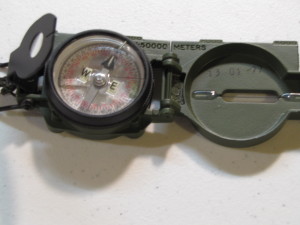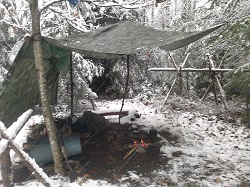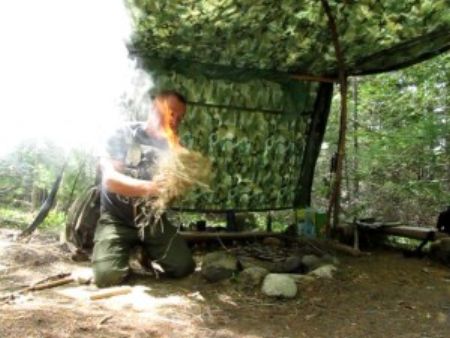How many blog posts have you read where the author talks about their bug-out bags and you think, “Holy cow, just the pack alone costs more than I make in a week!” I’m here to tell you that you don’t need to be rich in order to put together a good outdoor survival kit. Let me tell you the two most important things you’ll need in order to survive in the woods. Shhhh…. ready? Knowledge and experience. That’s all you need folks. Seriously.
By Jarhead Survivor, a contributing author SHTFBlog & Survival Cache
 Does gear help when you’re on a camping trip? Of course it does, but gear is a trade-off for experience – let me explain. If you’ve done a lot of camping with a sleeping bag and tent you’ve never had the experience or gained the knowledge on how to build a shelter out of natural materials.
Does gear help when you’re on a camping trip? Of course it does, but gear is a trade-off for experience – let me explain. If you’ve done a lot of camping with a sleeping bag and tent you’ve never had the experience or gained the knowledge on how to build a shelter out of natural materials.
If you’ve always used a lighter you’ve never had to worry about how to get a good spark from your fire steel. If you always use a fire steel you’ve never had to worry about what kind of wood to use for your bow drill set. If you’ve used paracord with your bow drill set you’ve never had to worry about using natural cordage. I think you get my point.
Don’t Depend On Gear
Once you can go into the woods with just your bare hands you’ll never *need* to depend on another piece of gear. Don’t get me wrong, gear is awesome and I love it, but it’s a good idea to always challenge yourself to try and get to the next level. Next time instead of using your lighter to start a fire use your fire steel. When you can do that no problem try doing it with a bow drill set you made with your own two hands.
Also Read: Top 5 Fire Starters
When you can build a shelter that will keep you as warm and dry as your tent and sleeping bag (or even better) then you’re well on your way to freedom in the woods. Living in the wilderness was a dying art, but I think it’s making a resurgence thanks in part to the Internet. My grandfather was a full blood MicMac Indian from New Brunswick and that man knew more about surviving in the wilderness than anybody. He would shoot a moose and find a way to use every part of it. He was a trapper and fisherman and it’s how he kept his family fed in the 30′s and 40′s; he didn’t do it because it was fun, he did it to survive.
I spent some time with him in the woods and on the river when I was a kid and when he went into the wilderness all he ever took was an axe, a small knife for skinning animals, and a lighter in his pocket. And he considered these items to be a luxury. Today I see many videos of men and women- both young and old – demonstrating how they live off the land, or give survival tips, or shoot survival videos, or what have you. It does my heart good to see these skills coming back into the mainstream.
How Does Knowledge & Experience Beat Gear?
Let’s use fire making as an example. If you can build a fire with one match you’ve got some skills. It means you can choose your  tinder, kindling, and wood carefully enough so that one light is all it takes to get it going. If it takes you half a butane lighter to get a fire going you have some learning to do, but that’s ok! Don’t get discouraged. We all have to start somewhere and building a fire can be a great way to get started.
tinder, kindling, and wood carefully enough so that one light is all it takes to get it going. If it takes you half a butane lighter to get a fire going you have some learning to do, but that’s ok! Don’t get discouraged. We all have to start somewhere and building a fire can be a great way to get started.
Now that you can build a fire with one match try and start it with a firesteel next time. This means you really have to understand what materials in nature can catch a spark and then utilize them to make a flame. You need to be standing by with your kindling to feed that small flame. Once it’s a little bigger you add thicker wood until you’ve got your fire built up.
Also Read: Compass vs. GPS
Once you can start a fire with a firesteel every time, you need to bump up your game with a bow drill. When you can create an coal with a bow drill set you’ve made yourself you are well on your way to surviving in the wilderness. The next thing you should try is build a shelter from natural materials. To do this properly is a lot of work, but when you have your shelter build you will be able to survive in any environment. A tent and sleeping bag rated to -30 is awesome, but knowing you have the knowledge in your head to make it yourself is pure power.
Also Read: 7 Tips For Your Bug Out Bag
Once you can build a shelter, start a fire with a bow drill, and make a container from birch or pine bark for boiling water you’ll be able to walk into the woods with a confidence born of experience and knowledge. Instead of a forbidding and dark forest you’ll start to notice things like water sources, hardwood trees with lots of leaves underneath for shelter making, game trails, birch trees with bark hanging off for fire starting, streams where fish live, stands of cat tails which have many uses, and on and on. You’ll know how to make your own cordage and what materials to make it from.r head to build one from the materials around you is pure power. You can walk into the woods and survive in comfort.
By having the understanding of how to do these things by hand you will have a supreme advantage over those without experience when it comes to spending time in the woods. Time to bug-out out to the wilderness. You’ve got the upper hand folks. Practice your skills!
Using Gear
When you’re able to do all these things without gear you quickly begin to see what a luxury a Kleen Kanteen can be, or how easy a fire is with a lighter, or how a poncho can quickly and easily be rigged into an overnight shelter in just a matter of minutes. You’ll have a new appreciation for even the cheapest piece of gear when you understand how to make them by hand from natural materials.
Packing Your Survival Kits
When I go into the woods I always carry a small pack with me and here are some of the luxuries I carry with me. Your pack will depend on your knowledge and experience, environment, and what you’re comfort level is. If I ever get lost or find myself in a survival situation and I have my pack with me the question isn’t, “Will I survive?” it’s, “How comfortable can I be tonight in this environment?”
So here’s a list of some of the things I carry:
- Military poncho and poncho liner (Shelter)
- Fire Starter (usually a fire steel)
- Survival Knife (need I say more?)
- Kleen Kanteen
- Alcohol stove or a Solo stove
- Metal cup and/or a small pot
- Head lamp/candle
- Compass (I always have a bailout azimuth in hand before heading into the woods)
- Paracord
- Cotton handkerchief
- Saw-vivor (total luxury item)
- Small first aid kit
With these few items I can be almost as comfortable in the woods as I would be at home. I can augment most of the gear here with things I can create in the wilderness. For example: instead of carrying a foam sleeping mat I can gather debris off the forest floor and use that as a barrier between me and the ground. It’s more comfortable and does just as good a job insulating me as a foam mat. And I don’t have to carry it.
BOB Creep
Bob Creep is a term I’ve coined for how your Bug Out Bag tends to gain weight slowly over time. You go to a store and see some widget hanging up and you think, “Sweet! I could really use that in my pack!” And you buy it and take it home and throw it in your BOB and forget about it. Then a week or two later you’re back at the sporting goods store and you see some other awesome gadget that would look real good in your BOB. You pick it up, take it home, throw it in your pack and forget about it. A year later your BOB weight has crept from 35 lbs to 60 lbs. How the hell did that happen? BOB creep, ya’ll. It’s insidious.
Also Read: 20 Things You Need In Your Bug Out Bag
I challenge you right now to go to your BOB (bug-out bag), GHB (get home bag), your day pack, your hiking pack, or whatever you carry around with you and see if you can lighten it up by at least five pounds. You’ll have to assess your own skill set and find out what you’re comfortable taking out of your pack. Think of it this way, the less gear you have to carry around the faster and easier you’ll be able to move.
How much weight did you cut from your pack?





